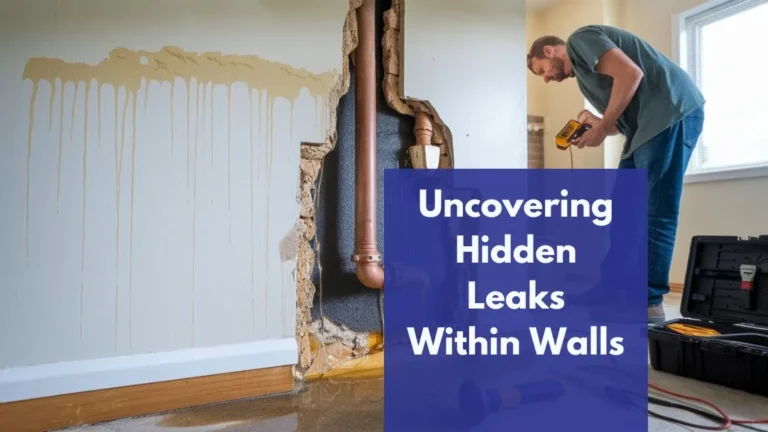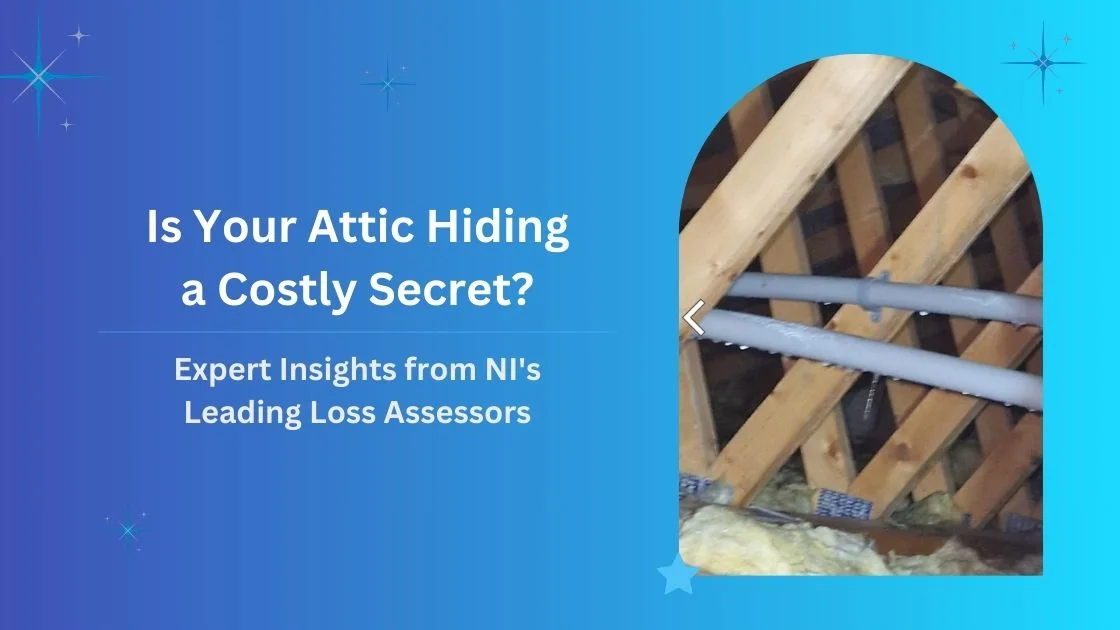Hidden leaks within your walls can cause extensive damage before they even become visible. Unseen and often silent, these leaks can lead to mould growth, structural issues, and increased water bills. In this article, we’ll explore effective techniques for uncovering hidden leaks in your walls. From using specialised tools to spotting subtle signs, learn how to detect these elusive leaks early and protect your home from potential damage.
Uncovering hidden leaks within walls requires a strategic approach:
- Begin with visual inspections for discolouration, musty odours, or peeling paint. Advanced detection methods such as moisture meters and thermal imaging can accurately highlight moisture zones.
- Furthermore, monitoring water meter readings for unexpected spikes may indicate underlying plumbing issues. Should these signs emerge, swift action is crucial; shut off the water and consult a licensed professional for thorough assessments.
- Understanding common leak sources, such as damaged roofing or plumbing failures, can aid in prevention.
Implementing effective strategies not only protects your home but also provides peace of mind.
Signs of Water Leaks
Identifying the signs of water leaks is vital for maintaining the integrity of your home, as even minor leaks can lead to significant damage over time. Homeowners should be vigilant for visual indicators such as discolouration on walls or ceilings, which often manifests as brown spots, signalling potential water intrusion.
Peeling paint or wallpaper also points to moisture issues, compromising material integrity. Odour detection plays an important role; a persistent musty smell is often linked to mould growth thriving in damp environments.
Furthermore, visible damp patches on floors or walls necessitate immediate attention, as they indicate accumulating moisture. Strange sounds, like dripping or gurgling, further suggest active leaks, urging prompt investigation to prevent costly repairs and guarantee a safe living space.
Detection Methods
Detecting hidden leaks in walls requires a systematic approach that combines technology and keen observation.
Employing non-invasive leak detection techniques is paramount for effective leak detection. Moisture meters can disclose moisture content; readings above 1% warrant further investigation. Moreover, infrared cameras allow for the detection of temperature variations, highlighting cold spots indicative of water intrusion.
Visual inspections for signs such as discolouration and water stains serve as essential preliminary steps. In addition, monitoring water meter readings for unexpected spikes can reveal hidden plumbing issues once all water sources are shut off.
For enhanced accuracy, professional equipment such as acoustic sensors and thermal imaging can pinpoint leaks in hard-to-reach areas, ensuring homeowners can tackle these hidden problems with confidence and precision.
Immediate Actions
Once a leak is identified, swift action is imperative to mitigate damage and costs.
Initiate your emergency response by promptly shutting off the water supply to halt further water damage. Safety is paramount; disable electrical breakers in the vicinity to reduce the risk of hazards.
Engaging a professional leak detection service ensures the leak’s source is accurately located and assessed using advanced detection techniques.
Meanwhile, begin draining and drying affected areas, focusing on thorough ventilation and dehumidification to combat mould growth.
Finally, arrange for necessary repairs, restoring damaged materials and implementing effective waterproofing measures.
These immediate actions not only protect your home but foster a sense of community and belonging through shared knowledge and proactive safeguarding.
Causes of Water Intrusion
Water intrusion is often the result of common leak sources such as damaged roofing materials, faulty gutters, and cracks in exterior walls.
Furthermore, weather-related vulnerabilities, including heavy rainfall and ageing building materials, amplify the risk of leaks infiltrating a structure.
Understanding these causes is essential for effective prevention and mitigation strategies.
Common Leak Sources
Identifying common leak sources is essential for maintaining the integrity of any building. Understanding these hidden leak locations helps prevent extensive damage and costly repairs.
Here are four primary wall moisture sources to take into account:
- Roof Leaks: Damaged tiles or flashing can allow rainwater to infiltrate your walls.
- Faulty Gutters: Blocked or poorly installed gutters lead to overflow, enabling moisture penetration.
- Cracks in Exterior Walls: Even minor cracks can facilitate significant water intrusion during rain or snowmelt.
- Poor Drainage Systems: Ineffective drainage causes water pooling near foundations, resulting in wall seepage.
Weather-Related Vulnerabilities
Exacerbating existing vulnerabilities, severe weather conditions pose significant risks for water intrusion in buildings. Heavy rainfall and rapid snowmelt can overwhelm drainage systems, leading to catastrophic leaks.
High winds may dislodge roof tiles or damage flashing, creating pathways for rainwater to infiltrate walls. Additionally, freeze-thaw cycles can fracture exterior walls, allowing moisture to seep in during warmer spells.
Ageing caulking and weather stripping around windows and doors further heighten the risk, particularly during storms. Effective rainwater management and proactive seasonal maintenance are essential in mitigating these vulnerabilities.
Professional Assistance
Engaging professional assistance for leak detection is crucial for homeowners seeking to safeguard their properties from hidden damage. By hiring licensed specialists, homeowners can ensure that leaks are accurately identified and addressed before they escalate into costly repairs.
Here are four compelling reasons to seek professional help:
- Expert Techniques: Professionals employ advanced tools such as thermal imaging and acoustic detection to locate leaks without causing damage to walls.
- Cost Savings: Timely intervention by experts can prevent extensive damage, thereby saving significant repair costs.
- Regulatory Compliance: Certified professionals are knowledgeable about local building regulations, ensuring all work meets legal standards.
- Service Warranties: Hiring experienced specialists provides access to warranties, offering peace of mind and assurance of quality work backed by their professional qualifications.
Advanced Tools for Detection
Detecting hidden leaks requires sophisticated technology that goes beyond traditional methods.
Thermal imaging cameras reveal temperature discrepancies that indicate moisture intrusion, while moisture meters provide quantifiable data to confirm suspicions.
Furthermore, acoustic detection techniques utilise sound to identify leaks, ensuring that no water escape goes unnoticed.
Thermal Imaging Cameras
A notable advancement in leak detection technology, thermal imaging cameras offer an unparalleled method for identifying hidden moisture and leaks within walls.
By employing infrared technology, these cameras detect temperature variations and reveal heat signatures that indicate potential water intrusion.
Consider the benefits of thermal imaging:
- Non-invasive scanning: Quickly assess large areas without damaging surfaces.
- High accuracy: Studies show up to 95% improvement in leak detection.
- Time-efficient: Reduce inspection time considerably compared to traditional methods.
- Cost-effective: Minimise the need for extensive repairs due to early detection.
Embracing this technology not only enhances leak detection but also fosters a community committed to maintaining a safe and dry living environment.
Moisture Meters Usage
Utilising moisture meters is essential for accurate leak detection in residential and commercial properties. These reliable tools measure moisture content in various building materials, with readings above 1% indicating potential leaks. Understanding the different types of moisture meters enhances your inspection capabilities:
| Type | Functionality |
|---|---|
| Pin-Type Meters | Precise measurements in specific areas |
| Pinless Meters | Non-invasive scanning of larger surfaces |
| All-in-One Meters | Combines functionalities for versatile use |
| Digital Meters | Features data logging for comprehensive tracking |
| Calibration | Regular calibration ensures accurate readings |
Regular use of moisture meters can prevent costly water damage by identifying leaks early. With advanced models offering digital displays, you can monitor moisture levels over time, ensuring your property remains safe and sound.
Acoustic Detection Techniques
Moisture meters provide a solid foundation for identifying water intrusion; however, they represent only one aspect of a comprehensive leak detection strategy.
Acoustic detection techniques exploit sound analysis to pinpoint hidden leaks with remarkable accuracy. By employing sensitive microphones and sensors, these methods capture the sounds of escaping water, including ultrasonic detection in ranges beyond human hearing.
Here are four key benefits of acoustic detection:
- Precision: Identifies exact leak locations, minimising guesswork.
- Non-invasive: Reduces the need for destructive inspections, preserving wall integrity.
- Advanced technology: Machine learning algorithms enhance leak identification efficiency.
- Noise differentiation: Distinguishes leak sounds from normal background noise, improving accuracy.
Incorporating these techniques can transform your approach to leak detection, fostering both efficiency and peace of mind.
Preventing Future Leaks
Homeowners’ vigilance is vital in preventing future leaks, as proactive measures can greatly reduce the risk of water damage.
Regular preventive maintenance, such as thorough plumbing inspections, is essential in identifying wear and tear before it escalates into significant issues. Insulating pipes in colder climates protects against freezing, while maintaining clear gutters and downpipes ensures proper drainage, preventing water from pooling against walls.
Educating household members about leak indicators—such as rising water bills or damp spots—empowers everyone to act swiftly. Furthermore, scheduling routine professional inspections fosters a communal sense of responsibility, allowing for timely interventions that safeguard the home.
Assessing Damage
Identifying the extent of damage caused by hidden leaks is a critical step in safeguarding your home. A thorough evaluation can prevent further deterioration and costly repairs.
Consider the following techniques:
- Conduct a visual inspection for discolouration, peeling paint, or warped surfaces on walls and ceilings.
- Utilise a moisture meter to measure moisture levels; readings above 1% may indicate leaks.
- Look for mould growth or musty odours, as they signal prolonged moisture presence linked to hidden leaks.
- Inspect both interior and exterior for cracks in walls or foundations, which can allow water intrusion.
Remember to meticulously document any visible damage and moisture readings, as this damage documentation is essential for professionals reviewing the situation.
Repair and Restoration Options
Restoration after hidden leaks demands a strategic approach to guarantee both immediate recovery and long-term resilience.
Effective repair techniques include drying and dehumidification to eliminate moisture and prevent mould growth. Structural repairs are essential; damaged plasterboard and flooring must be replaced to uphold integrity.
Mould remediation is critical, employing HEPA vacuums and antimicrobial treatments to create a safe environment. Addressing plumbing issues is non-negotiable—replacing faulty pipes ensures that leaks do not recur.
Ultimately, implementing restoration methods such as regular inspections and proper ventilation serves as a safeguard against future leaks.
Key Takeaways
- Conduct visual inspections for discolouration, peeling paint, and damp patches to identify potential leak areas.
- Utilise moisture meters to assess moisture levels; readings above 1% warrant further investigation.
- Employ infrared cameras to detect temperature variations, indicating hidden moisture behind walls.
- Monitor water meter readings for unusual spikes that may suggest plumbing issues.
- Engage professional services with advanced leak detection tools for accurate assessment and intervention.



